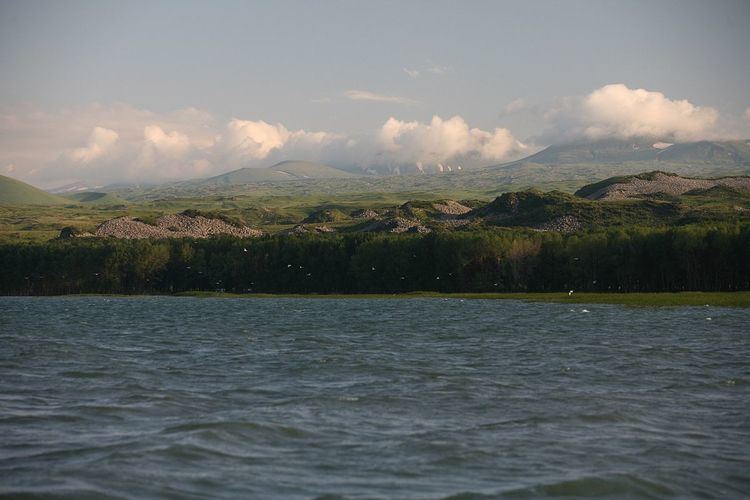Area 342 km² | ||
 | ||
Similar Dilijan National Park, Hayravank Monastery, Harsnaqar Hotel Complex, Սևանավ / Sevanav, Noratus Cemetery | ||
Sevan National Park, is one of the 4 protected national parks of the Republic of Armenia, founded in 1978 to protect Lake Sevan and the surrounding areas. It is under the jurisdiction of the Ministry of Nature Protection and includes a research center, which monitors the ecosystems, and undertakes various conservation measures. Licensed fishing on the lake is also regulated.
Contents
- Agbu glendale and pasadena scouts clean the sevan national park
- Mammals
- Avifauna
- Herpetofauna
- Ichtyofauna
- Terrestrial Invertebrates
- Flora
- References
Agbu glendale and pasadena scouts clean the sevan national park
Mammals
Scientific knowledge about the mammals of the Sevan basin is quite poor and fragmental. Wolf, jackal, fox, marten, cat, hare, small rodents are usually mentioned.
Avifauna
Sevan lake and its vicinity are rich in avifauna. Up to 267 bird species have been recorded in Sevan Basin. The known avifauna can be grouped into the orderss: Podicipediformes, Pelecaniformes, Phoenicopteriformes, Falconiformes, Anseriformes, Galliformes, Gruiformes, Charadriiformes, Columbiformes, Cuculiformes, Strigiformes, Caprimulgiformes, Apodiformes, Coraciiformes, Piciformes, and Passeriformes. 39 species are included in the Red Book of Armenia. There is also an endemic species Armenian gull (Larus armenicus).
Herpetofauna
In the Masrik River valley, the following species of reptiles and amphibians can be found: Bufo viridis, Hyla arborea, Rana ridibunda, Rana macrocnemis, Laudakia caucasia, Anguis fragilis, Eremias arguta, Lacerta agilis, Lacerta strigata, Parvilacerta parva, Darevskia unisexualis, Darevskia valentini, Platyceps najadum, Hemorrhois ravergieri, Coronella austriaca, Eirenis punctatolineatus, Natrix natrix, Natrix tessellata, Vipera ursinii.
Ichtyofauna
Masrik river and its tributaries flow in the proximity of the urban areas. The river is of great importance, since it is a spawning place for such endemic species as Sevan trout (Salmo ischchan), Sevan koghak (Capoeta capoeta sevangi) and Gokcha barbel (Barbus goktschaicus). Besides, the young fish of the aforementioned species also live in these rivers till one year of age. This period is very important for the future survival of the species. Sevan trout and Gokcha barbel are included in the Red List of Armenia as endangered species.
Terrestrial Invertebrates
On the whole territory of Gegharkunik marz in general, there are 55 groups of invertebrates, mainly arthropoda, mollusks, crustacea, arachnida, etc. There are a few dozens of endemic species, of which 44 coleoptera, 2 lepidoptera, 2 оrthoptera, 2 mollusks. There is no Red Book in Armenia for the invertebrates. In the Red Book of the USSR, there were 12 species of arthropoda, of which 6 butterflies, 5 hymenoptera and 1 cricket. In the IUCN Red List, there are 4 invertebrate species, inhabiting Sevan Basin, one of which is included in the list of Convention on the Conservation of European Wildlife and Natural Habitats (Bern Convention).
Flora
The basin of Lake Sevan is a crossroad for mezophile and Armenian-Iranian xerophile flora belts. In the territory of Sevan National Park 1145 species of vascular plants can be met, in the protection belt – 1587 species. The flora of the park is presented by 28 species of trees, 42 species of bushes, 866 perennial herbs and 307 species of annual and biennial plants. The territory of Sevan National Park and its protection belt, which also includes Vardenis, 23 plants, endemic for Armenia, can be met, of which 13 are endemic for Sevan floristic area. Only on the territory of Sevan National Park 3 Armenian endemic and 5 Sevan basin endemic plant species can be met. 17 species are included in the Red Book of Armenia (in the protection belt there are 48). In the territory of Sevan National Park and its protection belt, about 60 herbs can be used for officinal purposes. More than 100 are edible.
